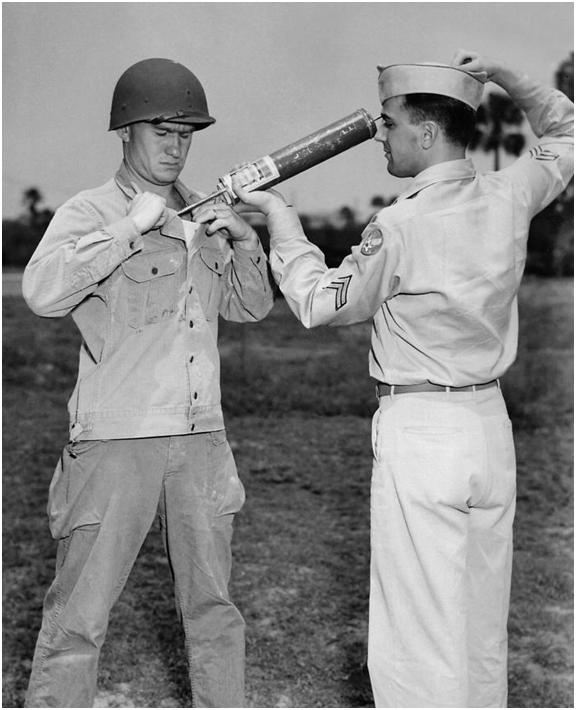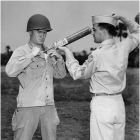In March 1951, Time magazine reported on the incredible success of two young Americans in Nicaragua. These city boys, who had “never so much as walked through a cotton patch” before, made $40,000 on their first cotton crop. The pair’s secret? Whilst envious locals removed crop pests by hand, “Frank and Dick were spraying insecticides under a hot tropical sun.” The incredible profits promised by cotton in the early 1950s ensured that Nicaraguans soon got in on the act: in June 1951 the US embassy estimated that cotton planters would require 10,000 pounds (roughly 4,500 kilograms) of 100% DDT for the following year. By 1958, the US Embassy was reporting that Nicaragua was “a green and pleasant land,” where “a prolonged Indian summer, $620,000 of fertilizers, and $3,100,000 of insecticides joined with a generous Nature to bring forth this season probably the largest [cotton] crop in Nicaragua’s history.”

US soldier demonstrates use of DDT to combat typhus-carrying lice.
US soldier demonstrates use of DDT to combat typhus-carrying lice.
Unknown photographer, n.d.
Courtesy of Center for Disease Control Public Health Image Library.
Click here to view source.
 This work is licensed under a Creative Commons Public Domain Mark 1.0 License.
This work is licensed under a Creative Commons Public Domain Mark 1.0 License.
The Nicaraguan cotton boom was made possible by Dichlorodiphenyltrichloroethane, or DDT. First synthesized in 1874 by a graduate student at the University of Strasbourg, DDT’s insecticidal properties were not discovered until 1939. During World War II, DDT was widely used by the US Army to combat insect-borne disease, and it was released for commercial use in 1945. David Kinkela shows how the so-called “excellent powder” came to epitomize US policymakers’ dreams of post-war modernity and progress based on economic growth and technological innovation. In time, the new chemicals would also become integral to post-war Nicaraguan ideas of nationhood. In “Zero Hour,” his poem about returning from exile on the eve of the Sandinista Revolution in 1979, Nicaraguan poet and revolutionary Ernesto Cardenal describes the “smell of insecticides” as the plane approaches his homeland as the “smell of Nicaragua.”
A combination of factors created a new culture of pesticide use in Nicaragua after World War II. Cotton was native to Central America, but the ubiquity of cotton pests had always made large-scale cultivation impossible. DDT made Central American cotton production consistently commercially viable for the first time. A spike in the price of cotton during the Korean War made cotton-growing particularly attractive and prompted the first farmers to take the plunge. As the first growers conjured up the kind of profits described in the 1951 Time article, more and more Nicaraguans chose to try their hand at cotton-farming. The pesticides boom was not simply a result of US intervention, therefore, but support from the United States certainly helped to facilitate the expansion of pesticide use in Nicaragua. President Truman’s “Point Four” aid program funded an agricultural advice service staffed by US experts, called the Nicaraguan Technical Agriculture Service. The Service, known by its Spanish acronym “STAN,” distributed leaflets promoting the new pesticides and explaining their use to Nicaraguan farmers. A 1953 STAN report took full credit for farmers’ spiraling cotton profits, commenting that “this year’s yields are better than 25 percent greater per acre than the 1952 crops solely because of more efficient use of insecticides as recommended and demonstrated by STAN.”

STAN pamphlet on control of cotton pests, 1952.
STAN pamphlet on control of cotton pests, 1952.
Digitized by Hilary Francis. Courtesy of the National Archives at College Park, Maryland.
 This work is licensed under a Creative Commons Public Domain Mark 1.0 License.
This work is licensed under a Creative Commons Public Domain Mark 1.0 License.
The optimism of the STAN reports obscures a much darker side to the rapid increase in pesticide use in Nicaragua. It quickly became apparent that DDT was ineffective against some cotton pests, such as the boll weevil, and other new pesticides were trialed. STAN entomologist Ralph Swain proudly reported that STAN’s work in Nicaragua had attracted considerable attention because “we were the first large scale users of the new insecticide Folidol, a product of the Bayer company of Germany.” In a journal article written in 1952, Swain once again praised Bayer’s products, noting that “a new insecticide from the Bayer company, Folidol E-605-m [Methyl Parathion], has been very effective.”
In fact, Methyl Parathion caused widespread poisonings in 1952 and was banned by the Nicaraguan Ministry of Agriculture in 1953 because of this. The ban was subsequently lifted as a result of the pleas of Nicaragua’s cotton growers. Despite the dangers, the profits promised by the cotton boom ensured that the use of pesticides continued and escalated, as increasing pest immunity meant that larger quantities were needed to achieve the same effect. A 1977 study of human tissue samples revealed that rates of DDT ingestion in Nicaragua were among the highest in the world. In 1980, Nicaragua imported 2,358,994 pounds (1,070,022 kilograms) of DDT, or almost half a kilogram for every single Nicaraguan alive at the time.
By the 1990s the availability of new synthetic products, coupled with spiraling pesticide costs, meant that cotton was no longer profitable in Nicaragua, but the environmental impact of the cotton boom was more persistent. DDT and other pesticides continue to affect water supplies, and a 2018 study of former cotton fields in Chinandega found that nearly 25 years after pesticides were last applied, the soils in the area contained so much residue that they were “still hazardous for agricultural use.” The profits made in the era of “white gold” are now a distant memory, but the impact of decades of intensive pesticide use shows no sign of disappearing.
Acknowledgments
The research for this article was funded by a British Academy/Leverhulme Small Research Grant and was conducted with the help of sources from the US National Archives, College Park, Maryland.
How to cite
Francis, Hilary. “‘Yanqui Cotton Patch’: US Development Aid and Pesticide Use in Nicaragua.” Environment & Society Portal, Arcadia (Autumn 2019), no. 39. Rachel Carson Center for Environment and Society. doi.org/10.5282/rcc/8877.
ISSN 2199-3408
Environment & Society Portal, Arcadia
 This work is licensed under a Creative Commons Attribution 4.0 International License.
This work is licensed under a Creative Commons Attribution 4.0 International License.
2019 Hilary Francis
This refers only to the text and does not include any image rights.
Please click on an image to view its individual rights status.
- Haller, Henrik, Anders Jonsson, Martha Lacayo Romero, and Martha Jarquín Pascua. “Bioaccumulation and Translocation of Field-Weathered Toxaphene and other Persistent Organic Pollutants in Three Cultivars of Amaranth (A. cruentus ‘R127 México’, A. cruentus ‘Don León’ y A. caudatus ‘CAC 48 Perú’)—A Field Study from Former Cotton Fields in Chinandega, Nicaragua.” Ecological Engineering 121 (October 2018): 65–71.
- Kinkela, David. DDT and the American Century: Global Health, Environmental Politics, and the Pesticide That Changed the World. Chapel Hill: University of North Carolina Press, 2011.
- Muller, G., and H. Von Eickstedt. “On the Introduction of Chemicals for the Protection of Cotton Crops in Latin America and the Middle East.” Pflanzenschutz-Nachrichten Bayer 22, no. 1 (1969): 47–55.
- Murray, Douglas L. “Social Problem-Solving in a Revolutionary Setting: Nicaragua’s Pesticide Policy Reforms.” Review of Policy Research 4, no. 2 (November 1984): 219–29.
- Swain, Ralph B. “Insect Problems in Nicaragua.” FAO Plant Protection Bulletin 1, no. 2 (1952): 27–28.
- Swezey, Sean, Douglas Murray, and Rainer Daxl. “Nicaragua’s Revolution in Pesticide Policy.” Environment 28, no. 1 (1986): 6–36.
- Thrupp, Lori Ann. “Pesticides and Policies: Approaches to Pest-Control Dilemmas in Nicaragua and Costa Rica.” Latin American Perspectives 15, no. 4 (1988): 37–70.








